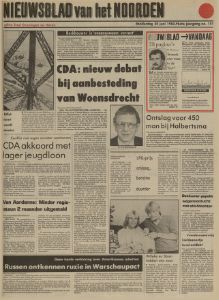About the day » Thursday June 30, 1983Calender converter
Born on Thursday June 30, 1983
- Blanca Barbara (Blanca) Koster, Maastricht
Died on Thursday June 30, 1983
- Andreas Knemeijer (71), amsterdam, Nederland
- Anna Barbara Ermans (86), Sittard Agnetenberg
- Anna Maria Josephina (Fieny) Bindels (72), Schaesberg
- Acidalia Amorim Moreira (88), Rio de Janeiro, Brasil
- Bauke Heidstra (48)
- Adrianus Antonius Kras (68), 's-Hertogenbosch
- Cornelia Elisabeth Sneekes (75)
- Cornelis Albertus Haan (91), Amsterdam
- Antonius, Wilhelmus Minneboo (75), Alkmaar
- Anna Theresia Voss- (82), Leeuwarden, Nederland
Source: Delpher (KB | national library) Newspapers from June 30, 1983 at Delpher
Born on June 30
- 1981 » Barbora Špotáková, Czech javelin thrower
- 1981 » Can Artam, Turkish race car driver
- 1981 » Matt Kirk, Canadian football player
- 1982 » Ignacio Carrasco, Mexican footballer
- 1982 » Lizzy Caplan, American actress
- 1983 » Cheryl, English singer and TV personality
- 1983 » Katherine Ryan, UK-based Canadian comedian and presenter
- 1983 » Marcus Burghardt, German cyclist
- 1984 » Fantasia Barrino, American singer-songwriter and actress
- 1984 » Tunku Ismail Idris, Crown Prince of Johor, Malaysia
Died on June 30
- 1971 » Georgi Asparuhov, Bulgarian footballer (b. 1943)
- 1971 » Georgy Dobrovolsky Ukrainian pilot and astronaut (b. 1928)
- 1971 » Herbert Biberman, American director and screenwriter (b. 1900)
- 1971 » Nikola Kotkov, Bulgarian footballer (b. 1938)
- 1973 » Nancy Mitford, English journalist and author (b. 1904)
- 1973 » Vasyl Velychkovsky, Ukrainian-Canadian bishop and martyr (b. 1903)
- 1974 » Alberta Williams King, Civil rights activist (b. 1904)
- 1976 » Firpo Marberry, American baseball player and umpire (b. 1898)
- 1984 » Lillian Hellman, American author and playwright (b. 1905)
- 1985 » Haruo Remeliik, Palauan politician, 1st President of Palau (b. 1933)
Names that were popular for boys in 1983
Names that were popular for girls in 1983
Source: Wikipedia Historical events 1983
- Koningin Beatrix (Huis van Oranje-Nassau) was from April 30, 1980 till April 30, 2013 sovereign of the Netherlands (also known as Koninkrijk der Nederlanden)
- In The Netherlands , there was from Thursday, November 4, 1982 to Monday, July 14, 1986 the cabinet Lubbers I, with Drs. R.F.M. Lubbers (CDA) as prime minister.
- The Netherlands had about 14.3 million citizens.
- January 27 » The pilot shaft of the Seikan Tunnel, the world's longest sub-aqueous tunnel (53.85km) between the Japanese islands of Honshū and Hokkaidō, breaks through.
- April 22 » The German magazine Stern claims the "Hitler Diaries" had been found in wreckage in East Germany; the diaries are subsequently revealed to be forgeries.
- May 6 » The Hitler Diaries are revealed as a hoax after being examined by new experts.
- May 20 » Church Street bombing: A car bomb planted by Umkhonto we Sizwe explodes on Church Street in South Africa's capital, Pretoria, killing 19 people and injuring 217 others.
- June 5 » More than 100 people are killed when the Russian river cruise ship Aleksandr Suvorov collides with a girder of the Ulyanovsk Railway Bridge. The collision caused a freight train to derail, further damaging the vessel yet the ship remained afloat and was eventually restored and returned to service.
- October 25 » The United States and its Caribbean allies invade Grenada, six days after Prime Minister Maurice Bishop and several of his supporters are executed in a coup d'état.
Weather June 30, 1983
The temperature on June 30, 1983 was between 12.4 °C and 18.2 °C and averaged 14.7 °C. There was 5.3 mm of rain during 5.5 hours. There was 0.4 hours of sunshine (2%). The almost completely overcast was. The average windspeed was 2 Bft (weak wind) and was prevailing from the west.

 June 29, 1983
June 29, 1983